So…what is an Osteopath?
This is something we get asked all the time.
Osteopaths are university trained experts in the structure of the human body and how it moves. We are government registered allied health professionals who focus on your neuro-musculoskeletal system - the bones, muscles, nerves and other tissues that support your body and control its movements.
Osteopaths are focussed on wellness. We treat the musculoskeletal system, but our primary objective is always to ask, “how is the musculoskeletal system reflecting or contributing to the overall health of the person we are treating?” Osteopaths ask, “Where is the the ‘ease’ in this ‘disease.’”
The Philosophy behind Osteopathy is centred on preventative medicine. We believe that if people move well, they can more easily engage in the behaviours that keep us healthy. Pain is draining, and restricted movement and muscle tension may lead to poor movement patterns that make it harder to cope with pain.
Osteopathic treatment aims to help you recover from injury, reduce pain and stiffness, increase mobility and prevent further injury. Osteopaths listen to your needs and use a range of assessments to develop an evidence informed treatment programme tailored to your individual condition.
How do Osteopaths treat?
Osteopaths use a combination of:
Hands-on therapy including massage, stretching, joint articulation, manipulation, indirect myofascial and ligamentous methods and visceral techniques.
Education and associated lifestyle advice
Exercise prescription
Each treatment is specific to you and your needs.
Why do Osteopaths treat the whole body?
Osteopaths treat the whole body because everything in the body is connected.
Joint or muscle pain is best treated as part of the whole body, since other parts of the musculoskeletal system will always be affected when one part of the body isn’t working well. For example, an ankle injury may mean that a person limps and favours the opposite foot. Over time, this imbalance can lead to other injuries, such as soreness in the other ankle, knee or hip, or back.
As Osteopaths, we want to treat your pain, but we also want to find out why your problem started in the first place. That is why we look at how your whole body moves and ask you to think about how you move during your day, during work and play.
Taking a whole body approach also means that we can tailor each session to you as an individual.
As Osteopaths, we help answer why you hurt and what you can do about it.
Freqently Asked Questions
What qualifications do Osteopaths have?
Osteopaths are government registered healthcare practitioners through the national agency AHPRA (Australian Health Practitioners Regulatory Agency). This means that they must adhere to strict guidelines around training and continuing professional development standards.
Osteopaths complete a four or five year university degree (honours or masters). Training prepares Osteopaths to be experts in how the body moves, with a focus on anatomy, physiology, pathology, general medical diagnosis and osteopathic techniques. Osteopaths are also trained to perform standard medical examinations of the musculoskeletal, cardiovascular, respiratory and nervous systems.
Osteopaths are required, by law, to maintain ongoing professional development and education every year to stay in practice. At Pivot Osteopathy we place an emphasis on exceeding the base requirements to ensure that we stay up-to-date with current research trends.
Osteopathy is not an alternative health option and has been practiced in Australia for over 100 years.
Do I need a doctor's referral?
No, you do not need a referral to make an appointment. If you are unsure whether Osteopathy is right for you, please do get in touch as our Osteopaths are happy to discuss your problem and how Osteopathy may assist you
Do Osteopaths accept referrals from Medicare Programmes, DVA, Worker’s Compensation and NDIS?
Yes they do. Please look on our FAQ page for more information about each type of referral
Is Osteopathy Covered By Private Health?
Yes, most private health funds cover Osteopathy in the extras packages. The amount you get back will vary by fund, so it is best to check with your individual fund.
Do Osteopaths work with other health professionals?
Osteopaths, doctors, and other health professionals will often work as part of a team to plan and manage treatment for a specific condition, especially if a person has a chronic condition
At Pivot, we are highly supportive of a team approach to care, particularly when a condition is chronic or complex.
We want to get you moving, but we know that to keep you moving well may require assistance from a wide variety of people and an increasing number of on-line tools. We think of this as a ‘toolbox approach’
A very brief history of Osteopathy
Osteopathy was developed by an American Medical Doctor called Andrew Taylor Still (A. T Still) in the late 1800s. He was practicing at a time when arsenic was still considered a medicine and germ theory was new. He found that the medicines of the day were just as likely to kill his patients as they were to heal them. But he noticed that if he helped people to use their bodies better (move better, breathe better, decrease their stress etc.) then they were more likely to recover from serious and not-so-serious illnesses.
Thankfully modern medicine has come a long way since the 1800s, but our bodies can still collect injuries and dysfunctional movement patterns that mean we’re not as healthy and vital as we’d like to be. Osteopathy still draws from the philosophy that the health of the physical body is integral to our well-being.
At Pivot Osteopathy we want to support you on your health journey by continuing Still’s philosophy that if your body moves well, you will be able to live better.
Andrew Taylor Still




